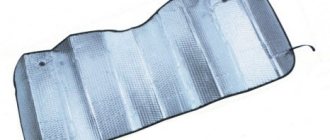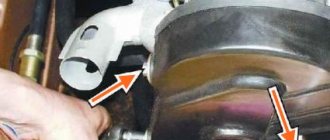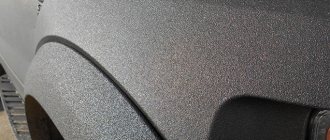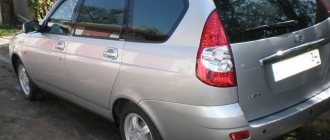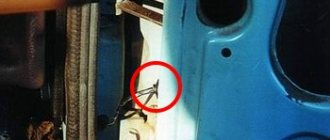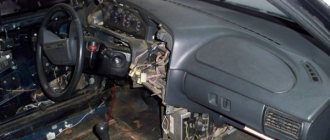If you decide to start painting your vehicle, it is likely that you will be faced with through holes in the body that have arisen as a result of exposure to rust. It is worth noting that body repairs are quite expensive, so not every car enthusiast wants to turn to professionals.
As a result, many are interested in how to repair holes in a car body without welding with their own hands. This is exactly what we will talk about now.
How to repair through holes on a car body using putty without welding
Before repairing a hole in the car body, you should prepare:
- fiberglass and automotive putty;
- aluminum mesh;
- putty knife;
- sandpaper (if possible, it’s also worth looking for a sanding machine);
- primer, paint, varnish.
Fixing holes in a car body itself is distinguished by its simplicity. First of all, you should remove the rust using an angle grinder or any other suitable equipment. Next, we cut out the patch from aluminum, and then attach it to the body using masking tape. We apply a thin layer of fiberglass putty (here it is important not to touch the tape, because then you will have to remove it). When the putty sticks, peel off the tape and putty the remaining areas.
It is important that the layer is as thin as possible, without tubercles or other irregularities.
When everything is dry, sand everything using coarse sandpaper or a sander.
Having achieved a flat and smooth surface, apply a second ball of putty - automotive putty. We wait until it dries and level it again. Then the surface is primed (do not forget to cover the areas that do not require painting with film). When the primer is finished, you can paint the body.
It is worth noting that the patch will be more stable if you apply a couple of layers of putty on the back side. In addition, it is also possible to seal holes in the car body without welding using putty and without using a patch. In this case, it is necessary to apply a lining on the back side so that the composition is well fixed. On the other hand, this solution is only suitable for very small through holes.
Let's watch a detailed video on how to seal holes without welding:
How to repair holes in the bottom of a car
When getting your car in order, sometimes you have to find an unpleasant problem - a through hole in the bottom of the body. Some car owners immediately turn to a car service center for help, while others try to repair the hole on their own. In the second case, you have the opportunity to save time and money, and will also be able to master new car repair techniques, which is always useful and relevant.
Holes in the bottom
Many people do not have a large number of repair and construction tools and equipment, so not every car owner has a welding machine in their garage or workshop. In fact, if the hole in the body is no larger than a matchbox, it is quite possible to repair it yourself without welding. There are several ways to do this:
- cover the hole with putty;
- solder a metal patch;
- seal with epoxy resin;
- apply fiberglass and glue;
- install rivet connections;
- use galvanized metal sheet.
Galvanized sheet
Method for filling holes using putty
In the area of the hole in the bottom, the damaged coating, that is, the old layer of paint, should be removed, the metal should be cleaned, and treated with a special preparation - a rust converter. Then the working surface is degreased and primed. Next, prepare a putty solution of uniform consistency. For greater efficiency, fiberglass is added to it (most often with large elements). Then the composition is carefully applied to the damaged area. This is perhaps the most important part of the job. It is necessary to seal all the holes, cracks and microcracks that may arise around it. Application of the solution should occur in several stages, allowing each new layer to dry.
Sealing with putty
To achieve maximum fixation of the putty on the damaged area, a backing is applied to the reverse side. It does not allow the solution to spread, but acts in the area that needs to be repaired. If the hole in the bottom of the car is large enough, this repair method can also be used with auxiliary elements. Instead of a lining, a metal mesh is installed in the damaged area. Therefore, the putty is evenly distributed over it, filling the entire space. After the solution has completely dried, this area is treated with automotive paint putty. Then the damaged area is painted and a protective film is applied.
Using a soldering iron
There is another way to repair a hole in a car body without welding. A soldering iron is required here. First of all, we clean the area from rust. We make the patch from a sheet of metal (you don’t need to worry too much about this; an ordinary can of auto chemicals will do).
It is important that the patch is slightly larger than the holes and also completely covers them.
Additionally, you can coat the metal surface with anti-corrosion compounds - this will increase the quality of our repairs. Then we service the edges of the patch, after which, using a fairly powerful soldering iron, we solder it with a continuous seam.
Next, you should check whether it turns out that the patch protrudes somewhat above the body. If there is a protrusion, we eliminate this deformation with several gentle blows of the hammer. We remove various dents with putty (it is important that its layer reaches no more than 2-3 mm, otherwise the material will crack). Before filling, clean the surface with a metal brush.
In order for the putty to adhere well, it is important that abrasive marks (small scratches) appear on the patch.
The next step is primer. Here it is necessary to complete everything as quickly as possible to avoid the possibility of rust occurring in the future. It is best to first apply a thin layer of phosphate primer, and when it dries, another two or three layers of acrylic two-component composition (the interval between applications should be about 5-10 minutes). Everything dries in about 3-4 hours; if there is infrared heating, you can reduce the procedure to 20 minutes.
It is worth noting that this solution is more durable than in the case of aluminum mesh, and it can be used to eliminate holes of almost any size.
Corrosion repair without welding
The body of any car is its most expensive part, and therefore requires constant care and cosmetic repairs. Perforation corrosion is a problem with many modern cars. Are there ways to avoid buying a new car frame and how to repair a hole without welding - these are two pressing questions of many car owners.
The cost of work at car repair shops is impressive, so many people prefer to repair their cars themselves.
Tools and materials required for work
Repairing corrosion without welding is the cheapest and easiest way to fix the problem. To do this you will need to buy the following set:
- Aluminum mesh with a size of approximately 25*18 cm;
- Scotch tape (preferably metal);
- Fiberglass putty;
- 80 or 120 grit sandpaper;
- Air machine for leveling surfaces;
- Universal putty;
- Primer;
- Paint (to match the body);
- Varnish;
- Paint polishing products.
Stages of work execution
All work to quickly eliminate a hole in the body without welding is carried out in stages:
- Cleaning the damaged area from rust and paint;
- Fixing an aluminum mesh with tape to an empty area of the body (there should be space between the tape strips to fill the mesh with putty);
When attaching the mesh, it is necessary to make maximum efforts to fix it flush with the car fender.
- The space between the attached tape on the mesh is filled with fiberglass putty. In this case, you need to carefully rub the material into the cellular mesh structure to form a sufficiently thick layer;
- After the putty has dried, the tape is removed;
- Re-application of putty to finally fill the hole in the body;
- The hole in the body is puttied both outside and inside. The result should be a strong and neat patch;
- The dried surface should make a dull sound when tapped;
- Leveling the patch with coarse sandpaper of 80 or 120 grit. In this case, you can use special equipment, for example, an air machine to obtain a more even surface of the patch being formed;
- Applying a universal putty composition and sanding again;
- Cleaning the work area from dirt and dust, covering its perimeter with tape;
- Applying primer first, then paint;
- The next stage is coating the repaired area with varnish;
- The final step is polishing the repaired area.
If you look closely, corrosion repairs without welding will be noticeable on the body. However, this method of solving the problem requires little expense; even an inexperienced car owner can cope with the work. You can use putty on the hole only if there is minor damage to the body.
If body corrosion is removed with mesh and putty, the service life of the patch is from one to two years.
This method is used only in emergency cases: urgent inspection or preparing a car for sale. If the car is expensive and the owner does not intend to change it, it is better to entrust the work to car service professionals. And one more important detail - if corrosion has affected most of the car body, the expensive part will have to be replaced with a new one.
How to pay TWICE LESS for GASOLINE
- Gasoline prices are rising every day, and the car's appetite is only increasing.
- You would be happy to cut costs, but is it possible to live without a car these days!?
But there is a completely simple way to reduce fuel consumption!
Don't believe me? An auto mechanic with 15 years of experience also didn’t believe it until he tried it. And now he saves 35,000 rubles a year on gasoline! Read more about this at the link. KuzovSpec.ru
Body repair with putty
This method is used when you urgently need to repair a small hole without welding or there are no other options for car repair. However, it should be understood that this is a temporary measure, since the putty will quickly crumble. To repair the damage, use a special putty with small, medium, and large glass fibers. When preparing it, you need to ensure that there are no air bubbles. To create an even layer, a lining is installed on the back of the hole.
A primer is applied to the prepared area of damage. After it dries, putty with large fibers is applied. Depending on the size of the hole, several layers are applied and each layer is completely dry. The total thickness should not exceed 2 mm, otherwise the patch will begin to crack. The last layer is applied with fine fiber putty. The repaired surface of the car is treated with fine-grained sandpaper.
Fiberglass and mesh
To repair more extensive damage, an aluminum patch mesh is used. A piece slightly larger than the hole is cut out of it and attached with masking tape. Next, sealing holes in the car body without welding is carried out in the following sequence:
- a thin layer of fiberglass putty is applied without touching the tape;
- after drying, the tape is removed;
- subsequent layers of putty are applied after the previous one has dried;
- the surface of the car is treated with sandpaper or a grinding machine until smooth;
- To strengthen the mesh, several layers of putty are applied to the back of the body.
Long-term auto patches are made from fiberglass and epoxy resin. Several overlays are cut from it, the first of which should cover the hole with a margin of 2 cm. The size of each subsequent piece is made larger than the previous one. The last overlay should cover all the metal stripped during the preparation process.
The cut pieces are impregnated with resin and placed on the hole in a sequence of increasing sizes. If you need to seal large holes on the back of the body, use linings to prevent the fabric from sagging. After laying all layers of fiberglass, wait for the resin to completely harden. The time required for this is indicated in the instructions.
Car body soldering
This method is used to seal small and large holes without welding. To work, you will need flux, which will protect the metal from rapid oxidation. Soldering acid, sold in radio stores, can successfully cope with this task. To achieve the required temperature, you will need a soldering iron with a power of 1 kW or more, or a version heated with a blowtorch, but it is better to use a gas torch. The solder is chosen to be refractory, since it can be used to repair a hole in the car body more reliably.
Preparing to fill a hole in a car body
So, you have discovered a through hole in the body of your car. do not rush to turn to expensive craftsmen who guarantee the high quality of their work with a guarantee that rust will not appear in this place for many years. If you are limited in funds, such treatment will lead you into debt and taking out loans. An alternative to this development of the situation may be to repair the hole in the car body yourself.
First, you need to prepare to seal the hole in the car body. To do this, you need to go to the nearest car market or auto parts store. We will need materials for working with paintwork and metal car body panels:
- fiberglass and epoxy glue;
- high power soldering iron;
- a hammer with a wooden striker or a hammer and a wooden spacer;
— acid rust converter;
— putty, automotive enamel;
— two-component acrylic primer;
— two-component acid (phosphate) primer.
Next, the place on the car body is prepared where a through hole has appeared due to natural corrosion. It is necessary to thoroughly clean the surface at a distance of several centimeters around the hole in the body panel using sandpaper. We must remove a layer of varnish, paint, possible putty and sand off any traces of rust. The surface around the hole should be thoroughly treated with an anti-corrosion solution.
Rivets
This method not only repairs large holes in the car body, but also replaces parts (fenders, aprons) without welding. In terms of reliability, it is not inferior to welding. It is recommended to install rivets in an inconspicuous place. Since there is no splash of molten metal during operation, like welding, it is often used to repair car floors.
The riveter required for the job can be bought in a store (costs approximately 500 rubles). The technology is simple:
- The patch is cut so that it overlaps 2 cm around the edges of the hole.
- By attaching it to the body, it is given the desired shape.
- The locations of the holes for the rivets are marked.
- After drilling the patch with a drill according to the diameter of the rivets (4 - 6 mm), it is advisable to countersink the edges of the holes so that it fits more tightly to the surface of the car body.
- Having applied the patch again, the center of the first hole is marked and drilled.
- After riveting it and leveling it, the patches are tapped and the remaining holes are drilled in place.
- To ensure a tight fit of the patch to the car body, rivets are fastened from the center to the edges.
- To prevent moisture from getting inside, the joint around the perimeter and rivets is coated with sealant.
Repairing body damage without welding
Content:
Restoring the integrity and appearance of a vehicle using welding is often not economically feasible, and sometimes impossible or unreliable. Then methods of repairing bodies without welding are used. It is not recommended to restore load-bearing elements in this way, especially on your own.
Weldless repair methods
Almost all body work without welding is classified as unprofessional. They are not the result of any developments in this area, they are based on the use of the properties of certain materials and substances, and do not have a clear technology tested and regulated by relevant institutes, organizations, standards and GOSTs. This is the fruit of folk wisdom and ingenuity of domestic craftsmen, initiated by the specific conditions of our life. For example, in Europe, no one would think of trying to repair a damaged body part or a damaged car - they are simply replaced with new ones. These methods are aimed, first of all, at eliminating through-through damage to the front surfaces and underbody of the car.
General requirements and rules are as follows. If necessary, use a grinder to cut out or expand the damaged area. The area to be repaired is cleaned of paint, rust, and dirt. Treated with anticorrosive or zinc, degreased. After filling the hole, a surface of the desired configuration is formed at the repair site; if necessary, painter's putty is used. Then the body is prepared for painting.
Puttying
Use putty with fiberglass. It comes in the following types:
- with small glass fibers;
- with averages;
- with large ones.
To seal through damage, use a composition with large fibers. The method is suitable for small holes or when significant damage is located in the area of structural “pockets” that protect large masses of putty from shedding (for example, the front part of the hood above the radiator grille). To fix the composition during work, you can use pads that are installed on the back side of the damage. Puttying is the most unreliable method. They are used mainly as a last resort for urgent repairs and when there are no other alternatives.
Before starting work, the stripped metal of the body is primed. When mixing putty with hardener, bubbles should be avoided. The composition is first coated inside and then laid on top. When the damage is significant, work is carried out in several stages. Allow one layer to dry, then apply the next one. Drying occurs naturally.
The use of aluminum mesh allows you to repair more significant damage. It is applied to the hole and secured with tape. Upon completion of work, the tape is removed.
Fiberglass and glue
For more serious damage, use fiberglass and an adhesive composition made from epoxy or polyester resin. Fiberglass is used to reinforce the patch. This method is more reliable than the previous one and also requires preliminary priming.
Several overlays are cut out of fiberglass according to the shape of the hole. The size of the first ensures that the damage is overlapped by 2 cm. Subsequent pieces of fiberglass are larger than the previous ones, the last one completely covers the prepared bare metal of the repaired area.
The pads are impregnated with glue and installed, or applied to the damaged surface with glue applied in ascending order of size. To prevent the fabric from sagging during work, when there are large holes, linings are installed. At the end of the work, the resin is allowed to dry and set. The method is suitable for minor damage.
Soldering
Used to eliminate large damage. A patch made of a sheet of metal is pressed tightly against the body, the connection to which is made with solder. Flux is used to ensure soldering strength. This method is quite simple to implement and even a beginner can do it; In terms of reliability, it is something between welding and gluing. Solder and flux are selected based on the alloys of the metals being joined. Soldering is performed with a high-power electric soldering iron.
Main disadvantages:
- relatively high cost (due to the high price of solder);
- the connection is not strong enough (welding is much more reliable).
The metal patch should completely cover the hole. Before starting work, the soldering points on the plate and body are tinned (treated with solder and flux using a soldering iron). The larger the area of tinning and, accordingly, soldering, the more reliable the connection. If the soldered pad protrudes strongly, then it is leveled on the surface of the car part with a hammer. The resulting dent is repaired with putty.
Rivets
Rivet joints are used in body production - this is a fairly reliable method of repair. Allows you to repair large areas of damage and replace solid parts (fenders, aprons, for example). The attachment points should preferably be in an inconspicuous place. This method for repairing floors is better than welding, which in this case is quite unreliable.
The damaged area is cut out, and a new piece of metal or part fragment is placed in its place. The rivets must be steel - they are stronger and will not create conditions for electrochemical corrosion, unlike aluminum ones. Diameter 5 mm, for loaded areas (in side members) - 6 mm. When replacing parts and their fragments, rivets are placed focusing on the factory welding points. The rivets are painted before installation. You will need a special device - a riveter.
other methods
The bottom can be repaired using galvanized sheets and bolts. The damaged area is cut out. Cut out two pieces of galvanized steel – outer and inner. The floor is coated with bitumen mastic on both sides. The insulation must dry. Galvanized sheets are also treated with mastic before installation. The lower fragment is installed, fixed with self-tapping screws, the protruding parts of which are cut off in the cabin. An inner sheet of metal is applied. The structure is held together with bolts (M5 x 15 are suitable). Fixation is carried out sequentially around the perimeter to avoid bending of the sheets.
To repair large dents in the threshold that require replacement, the following can be used. Several holes are drilled in the threshold, a tool is inserted into them, and the bent area is straightened. The holes are removed using one of the above methods and, together with the residual dent, are prepared for painting.
pokraskamashin.ru
Final stage
Regardless of how the car body was repaired, they all end with putty. However, it absorbs moisture, which leads to rapid destruction. Therefore, it must be coated on top with an anti-corrosion or epoxy primer. Body repairs are completed without welding by painting. To do this, use a spray gun or aerosol cans, after covering the adjacent surface of the car with plastic film. You should not use a brush, as drips are possible.
The proposed methods will help to repair a car without welding in case of single damage. However, if a large area is affected by corrosion, it will be easier and more reliable to contact a car repair shop to replace the rusted area by welding. Most often this happens to the floor, so it is recommended to regularly check it from underneath the car using an inspection hole or lift.

